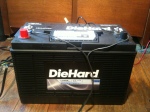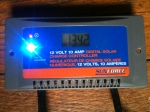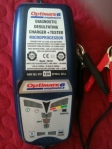Theory
The school server often needs to operate in classrooms where the power is not reliable. Sometimes, there is no grid power at all. To navigate these situations, some basic understanding of ELECTRICITY is really helpful. In my earlier life, I taught high school electricity, so it may not really be as important as I believe it to be!
Chapter 1: BASIC CONCEPTS OF ELECTRICITY contains enough information to get started building a solar system to power a school server. The important concepts to watch for are voltage (electron pressure measured in “volts”), current (electron flow measured in “Amperes”) , and power expressed in “watts” — electrons doing something useful (flowing through something that offers some resistance, expressed in “ohms” ). An even more condensed and polished introduction is written by Bill Den Beste.
The sun is a source of energy, which can be captured with a solar panel. I wanted to get some hands-on experience with solar, so I purchased this 100 watt panel on ebay (cost about $190 delivered), and attached it rather firmly outside my room. We had just survived hurricane Sandy, and I didn’t want it flying away when the wind came up. The most I have ever seen on the brightest day has been about 65 watts. But on the other hand I have not spent the time to calibrate and check all my equipment.
 The deep cycle lead acid batteries, often sold in the US for golf carts, sell for $150 -$300. I went to the local Sears store, and purchased the largest Marine/RV deep cycle battery, pictured here for about $120. (catalogue 50731 105AH)
The deep cycle lead acid batteries, often sold in the US for golf carts, sell for $150 -$300. I went to the local Sears store, and purchased the largest Marine/RV deep cycle battery, pictured here for about $120. (catalogue 50731 105AH)
 To keep the battery from being destroyed, due to overcharging, I used this 10A controller, purchased from Amazon ($33 — Sunforce 60031 10 Amp Digital Charge Controller ).
To keep the battery from being destroyed, due to overcharging, I used this 10A controller, purchased from Amazon ($33 — Sunforce 60031 10 Amp Digital Charge Controller ).
I used this simple system to run a School Server (an XO-1.75 running 24/7) for 2 months with only minor difficulty. There was a stormy week when the solar system was only providing 5 watts during the day, and the battery was loosing about 100 watt hours at night.
 I also purchased a 5 amp “smart” battery charger from Amazon (
I also purchased a 5 amp “smart” battery charger from Amazon (
OptiMate 6 Ampmatic battery saving charger-tester-maintainer — $107) which is dual voltage –110/240. It can be used to charge a battery when there is power from the grid some portion of the school day, but not necessarily when the power is needed. It has the necessary intelligence to keep from overcharging.  The reason I suggest this more expensive charger is that with a charging rate of 5 amps, it is properly sized to restore the energy that 10 XOs might use in a day, if the grid power is on for 6 hours during a 24 hour period.
The reason I suggest this more expensive charger is that with a charging rate of 5 amps, it is properly sized to restore the energy that 10 XOs might use in a day, if the grid power is on for 6 hours during a 24 hour period.
In Haiti, we had 20 XO’s, and we used the 15 Amp charger pictured at right. With 20 XO’s we needed to restore 600 watt-hours of energy each day, which this charger could do in about 4 hours.
The less expensive chargers, (I also bought a $27 Yuasa YUA1200901 Smart Shot Battery Charger which only charges at a .9 amp rate, and would need to charge the deep cycle battery for 3 hours to recharge a single XO).

